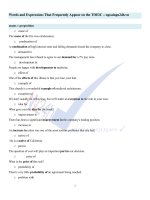That clauses
Bạn đang xem bản rút gọn của tài liệu. Xem và tải ngay bản đầy đủ của tài liệu tại đây (8.15 KB, 1 trang )
That-clauses
As a conjunction that has little real meaning. It simply connects two clauses.
I realized. She was innocent. (Two separate sentences.)
I realized that she was innocent. (One sentence – Here the clause ‘he was innocent’ becomes the object of the
verb realized.)
A that-clause can be the subject of a sentence.
That she should forget me so quickly was rather a shock.
A that-clause can also be the complement.
What is important is that she is safe.
Many verbs can have that-clauses as objects.
I knew that she was innocent.
The boy admitted that he had stolen the money.
Many nouns and adjectives can be followed by that-clauses as complements.
I admire your belief that you are always right.
That-clauses cannot follow prepositions directly. If we have to put a that-clause after a preposition, we use the
expression the fact that.
The judge paid no attention to the fact that the boy had just lost his parents. (NOT The judge paid no attention to
that the boy had just lost his parents.)
That-clauses after verbs, nouns and adjectives
Not all verbs, nouns and adjectives can be followed by that-clauses. For example, the words want, importance
and worth cannot be followed by that-clauses. Instead, we use to-infinitives or gerunds after them.
I want you to be happy. (NOT I want that you be happy.)
Stay on top of your writing! Download our grammar guide from www.englishgrammar.org to stay up-to-date.
Powered by TCPDF (www.tcpdf.org)









